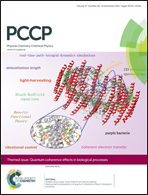Dual electron transfer pathways from the excited C60 radical anion: enhanced reactivities due to the photoexcitation of reaction intermediates†
Abstract
In the present study, electron transfer (ET) processes from excited radical anions have been investigated using dyad molecules including C60. The deactivation process of excited C60˙−, including the internal conversion from the D1 to the D0 state and the cooling process of the vibrationally hot ground state (Dhot0), was observed spectroscopically for the first time. These processes could be unambiguously distinguished by the observation of the stimulated emission from the D1 state. The intramolecular ET processes from the excited C60˙− were confirmed by the transient absorption spectra. Clearly, both D1 and Dhot0 states acted as precursors for the ET, i.e., dual ET pathways were confirmed. The driving force dependence of the ET rates was well characterized by the Marcus theory, which revealed that the forward ET processes are located at the top region of the Marcus parabola. In addition, the ET from the excited imide radical anion to C60 and that from the ground state C60˙− to imide were examined. The ET rate from the excited imide radical anion and that from ground state C60˙− did not follow the Marcus parabola estimated for the ET from the excited C60˙−. The observed difference can be attributed to the difference in the energy required to form the reduced spacer (Δ) in the superexchange mechanism. Because the Δ value tends to become smaller for ET processes from excited radical ions, fast and efficient ET processes are expected from these states as demonstrated in the present study.


 Please wait while we load your content...
Please wait while we load your content...